Goddess Isis & the Mooring Post of Flint
Part 1
If you’ve been flipping through the new edition of Offering to Isis, you may have noticed that two of Her sacred symbols—which can also serve as offerings to Her—are a mooring post and a knife.
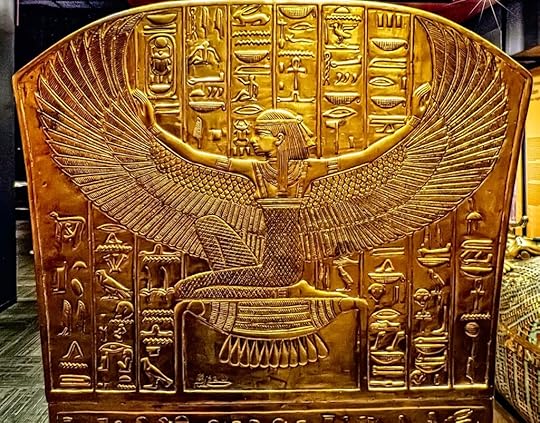 Isis protects the dead
Isis protects the deadIndeed, Isis Herself is called the Great Mooring Post, She Who calls us to our deaths. And yet the Great Mooring Post is also a comfort to and protector of the dead—and we, like Osiris, can rejoice when She greets us in the Otherworld.
The knife in question is the flint knife or des. Des just means “flint,” the material of the original knife. In ancient Egypt, the word des came to be used for all knives because of the ancient prototype.
I’m reading an article now that combines these two Isian symbols in the form of a heavenly mooring post made of flint. This is because, in the heavens, Isis as a hippo-formed Reret Goddess, uses a flint mooring post to chain the constellation Meskhetyw, “the Foreleg,” in its place in the northern night skies.
What’s all this about?
Let’s see what we can find out.
First, let’s look to the stars. There are two particular constellations involved: Meskhetyw, which corresponds roughly to the Big Dipper, and the constellation associated with Isis Reret and Her mooring post, which corresponds roughly to Draco.
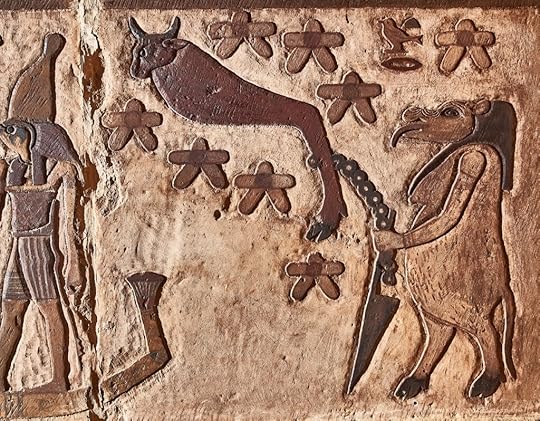 Reret chains the Foreleg in place among the stars
Reret chains the Foreleg in place among the starsBoth of these constellations are among the northern circumpolar stars. Circumpolar stars move counterclockwise around the celestial North Pole and never go below the horizon when viewed from the northern hemisphere. Because these stars could always, always be seen in the Egyptian night sky, the Egyptians called them the ikhemu-sek, the “Imperishable Stars.” They served as nightly visual proof of the everlasting celestial life that awaits us beyond death. The great Sky Goddess Nuet is described as containing the Imperishable Stars. And, of course, Her children, Isis and Osiris, are among the most important protagonists in the Egyptian understanding of life after death.
The angled khopeshThe Foreleg constellation was envisioned by the Egyptians as a bull’s foreleg. In the Pyramid Texts, it is the foreleg of Set, but it is also said to be the foreleg of a donkey or dog, beasts associated with Set. Yet, the text on the coffin of one of Egypt’s sacred bulls attributes the foreleg to Osiris, “the Bull of the Sky.” Meskhetyw might also be called the Khopesh of Set, for its resemblance to the angles of this type of Egyptian sword.
The Reret (meaning “sow”) constellation is envisioned as a female hippopotamus, standing on Her rear legs and with a crocodile perched on Her back. In different representations of the stars, this constellation is sometimes called Reret, sometime Great Reret, and sometimes Iset Djamet. By the time of the New Kingdom, the constellation is strongly connected with Isis.
A text in the tomb of Rameses VI explains it:
As to this Thigh of Set, it is in the northern sky attached to two firestone [i.e., flint] mooring posts by golden chains. It has been given in charge to Isis, in Her form of a female hippopotamus, Who guards it. The Water of His Gods is round about as Gods of the Horizon. Re has placed them behind it together with Isis, saying: “Prevent it going to the southern sky toward the Water of the Gods which issued from Osiris, He Who is behind Orion . . . They appear in the regions of the sky, in the northern sea [Egy. Wadj Wer, “Great Green;” the Wadj Wer can be identified as Osiris, with the Primordial Waters, and on earth, with the Mediterranean sea]. It is for them. The northern horizon is their country.”
Isis as a Reret Goddess
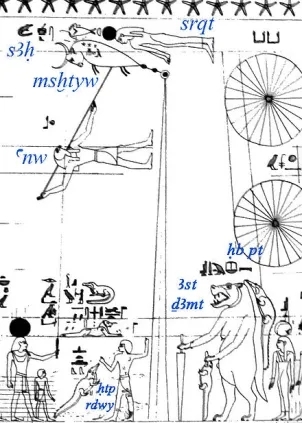
So Isis and the northern Deities, no doubt stars, guard the Thigh or Foreleg of Set. And since They are preventing the northern Waters, associated with the Foreleg of Set, from mingling with the southern Waters of Osiris, They are protecting Osiris from Set.
In the Papyrus Jumilac, from a later period, the Foreleg is said to be tethered “so that it cannot travel among the Gods.” In the temple of Esna, Reret secures the Foreleg “in order not to let it go upside down into the Duat [the underworld].”
From the tomb of Senenmut, which contains one of the key Egyptian astronomical diagrams, we find the female hippo constellation identified as Iset Djamet Heb Pet (heb pet is “heavenly festival” or “sky festival”). Djamet may be a place-name for Medinet Habu. It may also have other interpretations. Some Egyptologists suggest that djamet may refer to the crocodile on the Goddess’ back as other place-names with dja– are frequently written with the crocodile alone. Dja by itself could mean a firestick (remember the flint above) or—interestingly—a warrior form of Ishtar.
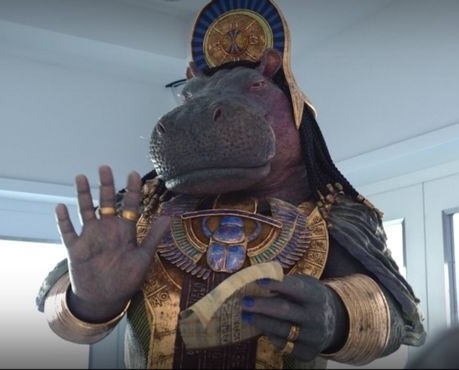 Taweret from Moon Knight; I kinda love Her
Taweret from Moon Knight; I kinda love HerThe article also suggests that the mt of Dja-mt could be a short form of the Goddess Mut meaning Mother. This is because, in another place in the tomb, this same constellation is called Mut the Fierce or h3s-mwt, the “Fierce Mother.” In this tomb, Isis and Mut are assimilated—as They often were in other places as well. Mut and Ipet, another Hippopotamus Goddess, are often assimilated, as are Isis and Taweret (“the Great One”).
And we all know that mother hippos (like mother lions; trust me, this will become relevant) are pretty dang fierce, right? Right.
So, an interpretation of Iset Djamet Heb Pet could be “the Heavenly Festival of Isis, the Fierce Mother.” Which would be appropriate for the Divine Work She is doing in the night sky—protecting Osiris from Set and keeping Set’s Foreleg or Thigh in it’s proper place in the heavens.
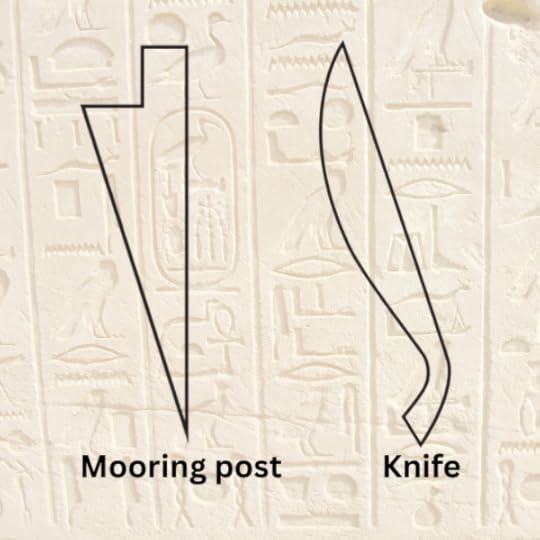
As a hippopotamus Mother Goddess, Iset Reret wields Her own fiercely protective nature and a mooring post of flint.
You can see here that the hieroglyph for “mooring post” and for “knife” are quite similar. So, you’ll probably not be too surprised to learn that, in later periods, the hippo Goddess of the Reret constellation was shown holding a knife rather than the similarly-shaped mooring post.
Knife and mooring post become even more indistinguishable in many apotropaic images of knives being stabbed into the coils of the enemy serpent Apophis (Apop) to defeat and subdue Him.
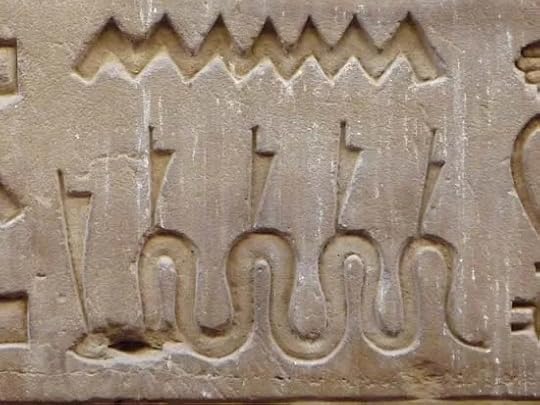 Knives (not mooring posts) subduing Apophis
Knives (not mooring posts) subduing ApophisAll of this is by way of set up for Part 2 of this post next week.
We’ll learn more about the connections between mooring post, knife, and flint—and where fire and Lioness Goddesses come into all this.
We’ll delve deeper into the symbolism of both mooring post and knife and see how they are particularly associated with Divinity and with Isis.
And we’ll talk about what we can do with all this information in our personal magical and spiritual work with Isis.



